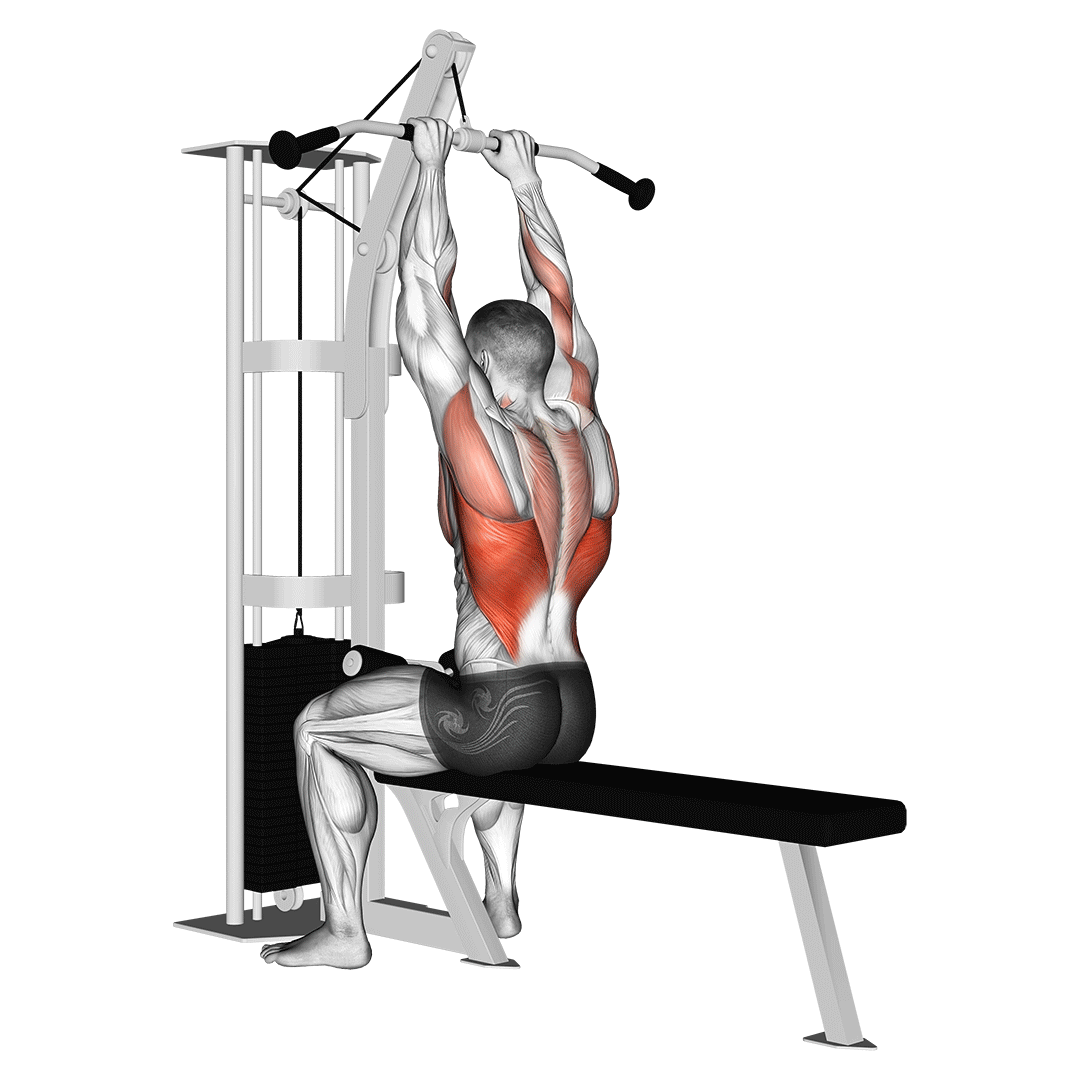The first time I hit a heavy lat pulldown set, I felt like a beast. Big stack, short rest, back on fire. But then… I stopped progressing.
Week after week, I loaded the same weight. No new growth. No stronger pull-ups. Just a lot of swinging and frustration.
That’s when I realized — going heavy wasn’t enough. I had no idea what “heavy” really meant for me. And worse, I was just chasing numbers without a real plan.
So I took a step back and figured it out: what counts as heavy, how to train it right, and how to actually build pulling strength — especially in a real gym setting where the machines don’t lie.
What Is a “Heavy” Lat Pulldown, Really?
When I first heard the term heavy lat pulldown, I thought it meant stacking as much weight as possible and just yanking it down. But yeah — I was wrong.
For me now, “heavy” means hitting that 6–12 rep range with clean form. If I’m grinding through reps 8 to 12, lats firing, staying tight — that’s heavy. If I’m swinging, jerking the weight, or pulling with my arms? That’s just ego.
Here’s how I started looking at “heavy” from all angles:
- Form first
Doesn’t matter how much you’re lifting if your back isn’t doing the work. I focus on pulling with my elbows, keeping my core tight, and controlling both the up and down.
No half-reps. No momentum. - Rep range matters
Anything under 6 reps on lat pulldown? That’s just too heavy for me — turns into a shoulder workout. I stay in the 6–12 range. Enough tension, enough volume. - Progressive overload = key
If I can hit 12 reps clean? Cool. Time to bump it up by 2.5kg. Just like with squats or bench — slow, steady increases work better than ego jumps. - Bodyweight changes the game
At 70kg bodyweight, pulling 60–70kg is pretty solid. But someone heavier might need more load to feel real fatigue. - Know the standards
Based on strength charts I checked (and some Reddit wisdom), 50–70kg is intermediate territory for guys. Women pulling 40–50kg with control? That’s impressive. - Listen to your body
Some days you feel like a machine. Some days the stack feels glued down. But hey, if my joints feel beat up or my grip’s trash that day, I just don’t push it — no point forcing bad reps.I adjust and move on. - Don’t swing it
Seriously. If the whole gym hears your reps, they’re probably not working. I had to stop using momentum and start using muscle. - Try stuff out
Wide grip, close grip, underhand, tempo reps — I switch it up. Some variations hit better depending on the day. - Add variety, not just weight
Going heavy isn’t just about the load. I do slower eccentrics, paused reps, and sometimes drop sets to keep pushing when I can’t add weight.
A “heavy” lat pulldown isn’t about maxing the stack — it’s about pulling with purpose, feeling your lats burn, and hitting failure with control. That’s what actually helped me grow.

Heavy Doesn’t Mean Sloppy: How to Actually Do It Right
I’ll be honest — I used to butcher lat pulldowns.
I used to believe I was lifting heavy, but that wasn’t the case. Instead, I was just swinging my body, yanking the bar, and crossing my fingers that my lats would grow. Spoiler: they didn’t.
Everything changed when I cleaned up my form. Here’s what actually helped me get stronger — and finally feel it where I was supposed to:
What clicked for me:
- Slight lean back — then lock it in
Not a full lean like I’m rowing. Just enough to get a good angle. Once I’m there, I don’t move my torso. - Elbows drive down, not back
This one was huge. I stopped pulling with my hands and started leading with my elbows. Boom — lat activation unlocked. - Core stays braced, always
I used to get pulled out of position. Now I brace like I’m about to deadlift. Makes everything tighter and more controlled. - No momentum, especially on the negative
This was the ego killer. I used to drop the weight on the way up. Now? I fight it. 3 seconds up. Lats on fire. - Control every rep — not just the first two
If my form falls apart by rep 6, that’s where I stop. Better to cut it short and stay clean than squeeze out junk reps.
Once I stopped flailing and actually moved with purpose, my numbers went down at first — but my progress shot up. It’s funny how that works.
Chasing the biggest number on the stack isn’t what matters. What really counts is maintaining max tension, performing clean reps, and avoiding any cheating. That’s how you make lat pulldowns actually heavy — and actually work.
Want to Build Muscle? Sometimes Less Weight = More Growth
I used to think I had to max out the stack to build a bigger back.
Turns out, chasing numbers wasn’t doing much — just messing up my form and burning out my grip.
Then I switched it up.
Instead of just going heavy all the time, I started training with more control. Slower reps. More time under tension. Slight pause at the bottom.
And honestly? My lats finally started to grow.
What I changed:
- Dropped the weight a bit
Not crazy light — just enough where I could really own every rep without swinging. - Increased reps to 10–15
Instead of failing at 6, I aimed for 12–15 clean reps. Way more pump. Way more tension. - Slowed the tempo down
2 seconds down, hold for 1, then drive it back up with control. Total game changer. - Focused on the stretch and squeeze
I let the lats fully stretch at the top, then squeezed like crazy at the bottom. Felt way more effective than just moving weight.
I still include heavy sets. But now I mix in these higher-rep, slower-tempo sets too.
Honestly? That combo has made the biggest difference in how my back looks and feels.
Moral of the story: more weight isn’t always better. Sometimes, backing off a bit actually pushes your gains forward.
How I Broke My Plateau and Got Stronger Pull-Ups
For the longest time, I was stuck.
Couldn’t do more than 2–3 clean pull-ups.
Lat pulldown? Capped out at 60kg, no matter how hard I pushed.
I figured I had to change something — not just grind harder.
Here’s what finally worked:
Deloaded and Fixed My Form
I dropped the weight. Yep — all the way back to 45–50kg.
Focused on clean reps, no momentum, full range of motion. It was humbling, but it worked.
Paused Reps and Stretch Holds
At the bottom of each lat pulldown, I held for a second and squeezed hard.
At the top, full stretch. It lit up my lats in a whole new way.
Trained Twice a Week
I split it up:
- Day 1 = Heavy lat pulldowns (6–8 reps)
- Day 2 = Volume and control (12–15 reps, slower tempo)
This combo gave me both strength and size.
Trained Arms Too
Surprise: my biceps and triceps were holding me back.
Once I started giving arms their own love, everything else — pull-ups included — got easier.
Results?
- My pull-ups went from 3 reps to 8 clean ones.
- Lat pulldown jumped to 75kg+ over a few months.
- All from dialing it back, training smart, and sticking with it.
Breaking plateaus isn’t about doing more — it’s about doing it better.
Strength Standards: Where You Might Stand (kg)
I remember wondering if I was weak, average, or doing alright.
Turns out, “heavy” looks different depending on your size and experience.
Here’s a rough guide I found super helpful:
For Men:
| Strength Level | Weight | Bodyweight Ratio |
|---|---|---|
| Beginner | 38 kg | 0.50x |
| Novice | 58 kg | 0.75x |
| Intermediate | 82 kg | 1.00x |
| Advanced | 110 kg | 1.50x |
| Elite | 141 kg | 1.75x |
If you’re pulling 60–70kg with good form? Solid middle ground.
Hitting 80kg+ and making it look smooth? That’s strong.
For Women:
| Strength Level | Weight | Bodyweight Ratio |
|---|---|---|
| Beginner | 19 kg | 0.30x |
| Novice | 31 kg | 0.45x |
| Intermediate | 46 kg | 0.70x |
| Advanced | 64 kg | 0.95x |
| Elite | 83 kg | 1.30x |
Honestly, I’ve seen women crush 50kg with better form than most guys.
If you’re in that range? Respect.
These aren’t hard-and-fast rules.
But if you’re lifting in a commercial gym, they give you a solid reference point—especially if you’re chasing a new PR or wondering how your numbers stack up.
What really matters? Progress, not comparison.
So yeah — chasing a heavy lat pulldown taught me more than just numbers.
Related Articles:
6 Best Lat Pulldown Grip Variations Explained
Close-Grip Lat Pull Down: Form Tips, Benefits & Real Talk
Lat Pulldown Muscles Worked: Why You Might Be Missing Lats
Supinated lat pulldown Grip: Ultimate Guide
Incline Lat Pulldown: Smarter Back Trainin
Should You Lean Back on the Diverging Lat Pulldown?
Best Bar for Lat Pulldowns Grew My Back
How I Started Using the Straight Arm Lat Pulldown
FAQs about Heavy Lat Pulldown
Yes, going heavy on lat pulldowns can help build strength, but it’s not the only way. What really matters is using a weight that challenges you within a good rep range (usually 6–12 reps) while keeping perfect form. Don’t just chase the heaviest stack; focus on controlled, clean reps to really target your lats and avoid injury. Mixing heavy sets with higher-rep volume work also helps with muscle growth.
Whether 100 pounds is “good” depends on your body size, training experience, and goals. For many lifters, especially beginners or lighter individuals, 100 pounds is solid and shows decent strength. For advanced or heavier lifters, it might be a starting point or moderate weight. The key is progression—if you can do 100 pounds with strict form and are gradually increasing, you’re on the right track.
Lats respond well to both high and moderate reps. High reps (10–15) with slower tempo and good time under tension can boost muscle growth by increasing fatigue and metabolic stress. But lower reps with heavier weights also build strength and size by pushing your muscles to adapt. Switching between rep ranges and tempos keeps your muscles guessing and growing.
Leaning back slightly during lat pulldowns isn’t necessarily bad; it can help engage the lats better. However, excessive leaning turns it into more of a row, which shifts focus away from the lats. Keep your core tight and lean just enough to maintain tension, but avoid swinging or using momentum. Controlled movement is key to targeting your lats effectively.

Hi, I’m the editor here at Leadman Fitness. We’re a manufacturer focused on producing top-quality barbells, plates, kettlebells, dumbbells, and strength training gear. I’ve been into sports and fitness for years, and I know my way around all kinds of gym equipment—both from using it and helping create it.
I spend a lot of time understanding the real problems people run into in the gym—whether it’s beginners trying to pick the right gear or experienced lifters looking for something more durable. I stay in close touch with our production team and talk directly with other equipment makers, so we’re always improving based on what real lifters and coaches are looking for.
What I share comes from hands-on experience—stuff that actually helps people train better, not just in theory, but in real gyms.
